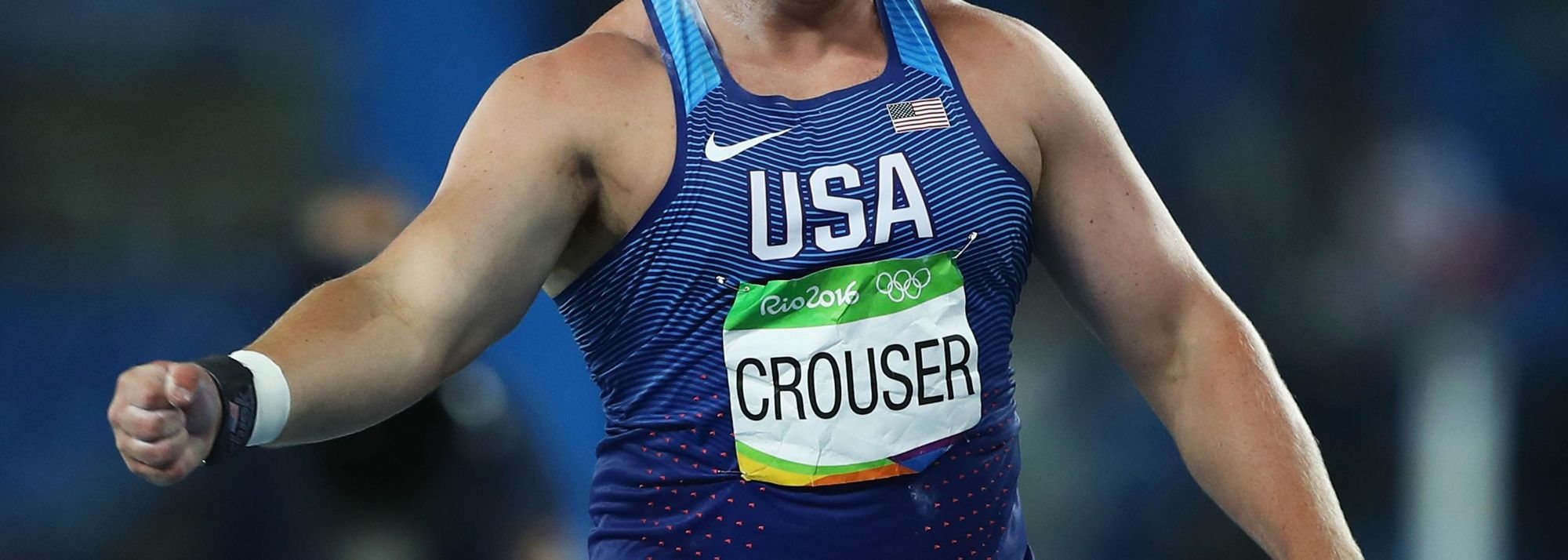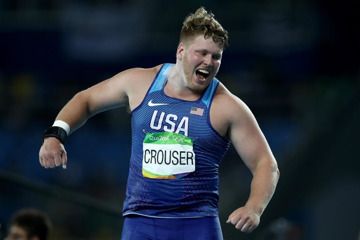2016 Olympic shot put champion Ryan Crouser in Rio (© Getty Images)
While cramming a two-year masters’ degree in finance into one year may not appear an ideal way to prepare for winning an Olympic title, this was the pretext to Ryan Crouser’s shot put glory in Rio.
The approach could be described as quirky, left field or old school depending on who you ask but ultimately the strategy worked. With the school work done, a note to his rivals: he will encounter no such distractions for his 2017 campaign.
You have been warned.
Rewind back to the summer of 2015 and Crouser began his masters’ degree at the University of Texas and set himself the goal of making the Olympic team. It was not easy.
“It was a real struggle to get through the past year,” says Crouser. “I was working five to six hours in the classroom every day, studying for an extra two to three hours and then had to fit training in. I became pretty good at walking and eating my breakfast and lunch between classes. The goal was to reach the beginning of May when my course was finished and hope I had done enough training to build on.”
Thankfully, the man from the small community of Boring, Oregon, not only survived, he thrived.
Stepping up his training in the period from early May to July’s Olympic Trials, he peaked to perfection. After a 21.85m PB in Chula Vista on 18 June, he went on to secure the US title with a world-leading 22.11m in Eugene to book his ticket for Rio. He was en route to 'the Greatest Show on Earth' and, as history has taught us, nothing was about to stop him.
From a family of throwers
That the Olympic shot put champion ended up throwing is no great surprise. His uncle, Brian, qualified for the US team in the javelin at the 1988 and 1992 Olympic Games. Crouser’s father, Mitch, finished fourth in the discus at the 1984 US Olympic Trials and his cousin, Sam, (son of Brian) qualified for the javelin at the Rio Olympics, where he finished 34th.
Some of Ryan’s first memories as a child were watching Sam throw a wooden javelin in his grandparents’ backyard.
Surprisingly, Ryan was initially more attracted to the sprints and jumps. He won a high school state title in triple jump before slowly graduating to the throws.
When he did specialise in discus and shot, he knew he could count upon the vast family knowledge and experience.
“Because of my dad and uncle, I developed lots of good habits early,” he explains. “I had a good foundation in the sport. My whole family have been very supportive.”
Double podium appearance at 2009 World U18 championships
Benefiting from the wealth of their experience, coupled with enviable throwing genes, he first made his mark on the global stage by landing gold and silver in the shot and discus, respectively, at the 2009 IAAF World U18 Championships in Bressanone, Italy.
He won the former event courtesy of a championship record of 21.56m with the 5kg implement and a glittering future was predicted.
“It was my first competition outside of the US and to see that much appreciation for track and field in Europe was eye-opening and really cool,” says Crouser, who that day defeated, among others, New Zealand’s Tom Walsh, the Olympic medallist and world indoor champion.
“Seeing how much people were into track really motivated me for the future.”
A stress fracture of the left foot sidelined him the following year and in 2011 he committed to the University of Texas in Austin. A high school valedictorian, academics have always been important to Crouser who felt the educational institution offered the best balance between academics and developing his track career.
Injuries marred his development but he was a class act. In 2013 he secured his first NCAA title; also that year threw beyond 21 metres for the first time with 21.09m in Waco, Texas.
The following year he improved to 21.39m and secured both indoor and outdoor NCAA crowns, but 2015 proved a year of frustration for the 2.01m tall Crouser.
Landing in the Olympic ring on his senior global championship debut
Opting to overhaul his training programme in the lead up to that year, he replaced lengthy periods of strength and then speed and power training by constantly mixing up his strength and speed and power training. Yet the strategy did not prove a success.
“I had hoped this training would be easier on the body, but it didn’t work out that way," admits Crouser.
“It just didn’t mesh with my body style, so last winter I went back to the original programme.”
The new training recipe seemed to be working and after his dazzling display at the US Olympic Trials, he went into Rio as world No.2 behind his compatriot Joe Kovacs.
Making his senior global championship debut, many questioned whether he would have the experience to deliver. However, he remained confident in his ability to perform.
“I knew my training had gone well and I had prepared well,” he explains. “It was the same seven-foot ring (I would be competing in) and 16lb ball (I would be throwing with) and I tried not to let all the other chaos of a big meet get in the way.”
After heading the qualifiers with a 21.59m effort, he took a stranglehold on the competition in round two with a mighty PB and world-leading mark of 22.22m. In round three he added a further four centimetres before unleashing a monster throw of 22.52m in round five, an Olympic record. Kovacs and Walsh could not respond. Crouser had struck gold.
“It definitely took some weeks to sink in,” explains Crouser, who then headed on to Europe to compete at both the Paris and Zurich IAAF Diamond League meetings. “It’s been a whirlwind (since winning gold) and it was only at the end of the season when I sat down on the couch did I realise quite what I’d done.”
World record assault – ‘I think it will happen before 2020’
Aged just 23, Crouser has recently relocated from Texas to be based out of the Olympic Training Center in Chula Vista near San Diego. He will continue to be coached by his father, although John Dagata will take on an overseeing role.
With no studies to act as a distraction, he is looking forward to fully committing to his athletics training and he believes there is room for improvement.
“I am still one of the lighter throwers and if I put on a bit more muscle mass, I think that will be a big help," he says. “As I mature, my strength will improve and I also hope to work on my flexibility.”
Yet there is another tantalising question. Given that Crouser has thrown 22.52m, could Randy Barnes’ 26-year-old world record mark of 23.12m be potentially under threat, given that Crouser – alongside Kovacs and Walsh – are all capable of well beyond 22 metres?
“I think it will happen before 2020,” he says. “We are such a young group and with four more years at least one of us should be over 23 metres.
"In fact, I think it is possible there could be multiple athletes over 23 metres. There is still a little way to go but with three guys pushing each other, that’s when we could see those performances over 23 metres. And 23.12m.”
Steve Landells for the IAAF





